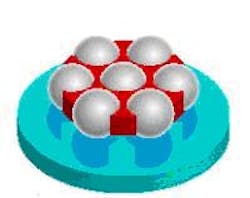Self-assembled glass/gold nanospheres achieve Fano resonance, could have interesting uses
Houston, TX--Scientists from four U.S. universities have created a way to use light-activated nanoshells from Rice University as building blocks for 2-D and 3-D structures that could find use in chemical sensors, nanolasers and optical metamaterials.1 The scientists are using the new chemical self-assembly method to build complex structures that can trap, store, and bend light.
Not natural
"We used the method to make a seven-nanoshell structure that creates a particular type of interference pattern called a Fano resonance," said study co-author Peter Nordlander, professor of physics and astronomy at Rice. "These resonances arise from peculiar light-wave interference effects, and they occur only in man-made materials. Because these heptamers are self-assembled, they are relatively easy to make, so this could have significant commercial implications."
Because of the unique nature of Fano resonances, the new materials can trap light, store energy, and bend light in ways that no natural material can. Nordlander said the new materials are ideally suited for making ultrasensitive biological and chemical sensors; they may also be useful in nanolasers and in integrated photonic circuits.
The research team was led by Harvard University (Cambridge, MA) applied physicist Federico Capasso and also included nanoshell inventor Naomi Halas, Rice's Stanley C. Moore Professor in Electrical and Computer Engineering and professor of physics, chemistry and biomedical engineering.
Heptamers and trimers, too
Nordlander, the world's leading theorist on nanoparticle plasmonics, had predicted in 2008 that a heptamer of nanoshells would produce Fano resonances. That paper spurred Capasso's efforts to fabricate the structure, Nordlander said. The new self-assembly method developed by Capasso's team was also used to make magnetic three-nanoshell trimers.
The nanoshells are gold-coated glass spheres, and are about 20 times smaller than red blood cells. Varying the sphere size and coating thickness tunes the interaction wavelength.
"Nanoshells were already among the most versatile of all plasmonic nanoparticles, and this new self-assembly method for complex 2-D and 3-D structures simply adds to that," said Halas, who has helped develop a number of biological applications for nanoshells, including diagnostic applications and a minimally invasive procedure for treating cancer.
REFERENCE:
1. Jonathan A. Fan et al., Science, Vol. 328, No. 5982, p. 1135, 28 May 2010.
About the Author
John Wallace
Senior Technical Editor (1998-2022)
John Wallace was with Laser Focus World for nearly 25 years, retiring in late June 2022. He obtained a bachelor's degree in mechanical engineering and physics at Rutgers University and a master's in optical engineering at the University of Rochester. Before becoming an editor, John worked as an engineer at RCA, Exxon, Eastman Kodak, and GCA Corporation.

